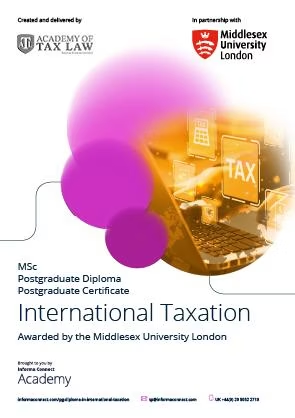POSTGRADUATE DIPLOMA IN INTERNATIONAL TAX
PG-Dip (Stage 2) builds on Stage 1, detailed on the PG-Cert page, and deepens international tax mastery. Students explore jurisdiction of tax, double tax relief, transfer pricing, general anti-avoidance, thin capitalisation, and CFC rules. They learn treaty purpose, interpretation, and application across OECD and UN Models. The module also addresses BEPS, Pillars One and Two, hybrid arrangements, services taxation, arbitration mechanisms, and the digital economy through cases, readings, and assessments.
Duration
12 months, part-time
Credits
120 University Credits
Effort
6–10 hrs/week average*
*Student dependent
Assessment
8x Coursework Assessments,
4x Module Assessments
Format
Online – Recorded lectures, Prescribed Reading, Live Q&As
Award
PG-Diploma, Middlesex
University

PG-Diploma (Stage 1+2) Overview
Exit Qualification: Postgraduate Diploma, or progress to Stage 3 for MSc (Master’s)

This award consists of 2 Stages. For the Postgraduate Diploma award Stage 1 & Stage 2 must be completed, consisting of 120 credits in total.
- Each stage contains two modules:
- Stage 1 – Introduction to International Taxation & Overview of International Tax Concepts, with 30 credits awarded per module.
- Stage 2 – Expanded International Tax Concepts & Specialised Areas, with 30 credits awarded per module.
- The learning will address important issues within the sector, drawing on key points, to ensure you gain a thorough understanding of the topics.
- Students must complete and successfully pass the assigned programme work assessments and the final exam at the end of each stage to claim their award.
- Pre-recorded academic lectures will be released each week, accompanied with the prescribed reading, any additional reading and/or research, as required. Directed reading will relate to provided case law, and will also include reading from legislation, books, articles, academic and professional journals.
- The learning from the lectures will be emphasised with an array of case studies, practice examples and resources, to challenge thinking in a practical context. Engaging activities on the discussion forum, the use of quizzes, polls and other forum built-in activity will further validate the learning objectives.
- Each main topic will end with a live-online tutorial, conducted by the lecturers. The tutorials are designed to be interactive, providing students with the opportunity to ask questions and to consider issues from different perspectives.
Progressing from Stage 1, students now hold a basic grasp of the principal international tax concepts, and this module deepens that foundation by expanding the Jurisdiction of Tax, Double Tax, and Transfer Pricing.
You will learn to identify where taxing rights arise for a transaction and why that allocation matters, since jurisdiction frames every subsequent analysis and anchors interpretation of international rules.
The module then examines double taxation relief in depth, showing how exemptions, credits, and treaty mechanisms operate and how to apply them coherently across different income categories.
Detailed guidance is provided on the arm’s length principle, the selection and application of transfer pricing methods, and the design of a defensible comparability analysis, including data selection, adjustments, and reliability testing.
Coverage extends across common intra-group dealings, including cost contribution arrangements, loans and advances, transactions in tangible and intangible property, and management and services charges, with attention to commercial substance and measurable value.
Throughout, you will build practical awareness of documentation requirements, from local file and master file expectations to supportive intercompany agreements, and you will situate those materials within the treaty context, learning how treaty provisions interact with domestic law to allocate taxing rights, prevent double taxation, and guide dispute resolution.
Learning Outcomes
On successfully completing this module, the student will be able to:
Course Content
- Comprehend, interpret and apply (most) International Taxation concepts.
- Interpret the impact of double taxation relief and its impact on a tax computation with considerations of credits and exemptions.
- Identify transactions that require the application of Transfer Pricing principles (as per the OECD guidelines), relating to the Arm’s Length Standard.
- Distinguish other types of Transfer Pricing transactions: loan/advances, use of tangible and intangible property, cost contribution arrangements.
- Demonstrate the Transfer Pricing documentation requirements and treaty aspects in Transfer Pricing transactions.
Knowledge (understanding)
- Fully comprehending Jurisdiction of Tax and its (far racing) consequences.
- Critically assess the double taxation relief principles of taxation of parties, the various methods of credits, tax sparing, underlying credits and how this is to be applied in tax calculations.
- Critically assess transactions where the Transfer Pricing principles are to be applied.
- Appraise the concept of the Arm’s Length Standard and the application of the various TP Methods and be able to perform a high-level Comparability Analysis,
- Identify and contrast cost contribution arrangements, loans/advance transactions, and the use of tangible & intangible property from other transactions.
- Cite Transfer Pricing transactions appropriately.
Skills (competencies)
- Fundamental understanding of tax jurisdiction in order to successfully understand, interpret and apply (most) International Taxation concepts.
- Interpret the fundamentals of double taxation relief and the impact on a tax computation taking into account the various types of credits/exemptions/relief which can be provided.
- Discuss and critically explain Transfer Pricing principles per the OECD guidelines, to identify transactions that require the application of Transfer Pricing principles relating to the Arm’s Length Standard, the various methods in determining the Arm’s Length Standard and the performing of a comparability analysis.
- Distinguish other types of Transfer Pricing transactions: loan/advances, use of tangible and intangible property, Cost Contribution Arrangements.
- Illustrate the Transfer Pricing documentation requirements and treaty aspects in Transfer Pricing transactions.
This module ensures a detailed, working understanding of general anti-avoidance principles, then develops thin capitalisation and controlled foreign company rules so you can apply CFC principles with confidence.
You will learn the legal nature and effect of tax treaties, the objectives they serve, and how to interpret them, with a concise walkthrough of core provisions in the OECD and UN Model Conventions. We unpack the structure and content of a Model Treaty and introduce special treaty issues that commonly arise in practice.
The module then examines emerging issues in depth, including base erosion and profit shifting, hybrid arrangements, and the taxation of management, technical, and consulting services, alongside arbitration frameworks for dispute resolution and the evolving rules for the digital economy.
Throughout, the focus is on translating doctrine into practice, reading treaty articles in context, and linking domestic anti-avoidance rules with treaty safeguards to prevent double non-taxation and resolve conflicts effectively.
Learning Outcomes
On successfully completing this module, the student will be able to:
Course Content
- Interpret and evaluate when and how to apply anti-avoidance measures to transactions, making use of tax treaties, thin capitalisation and CFC principles.
- Illustrate the contents included in Tax Treaties.
- Demonstrate key emerging tax issues, understand the tax impact and application thereof to specific transactions.
Knowledge (understanding)
- Recognise and interpret what Anti-Avoidance measures entail, and specifically how thin capitalisation, and the CFC Rules per International Tax principles are to be applied to assist with the anti-avoidance process.
- Evaluate the legal nature and effect of Tax Treaties and how these Treaties are to be interpreted and applied.
- Identify the contents of a Model Treaty and which Special Treaty aspects are to be included.
- Assess and appraise various emerging issues within the broader International Tax environment, namely: Base Erosion and Profit Sharing, Hybrid Arrangements, taxation of management, technical and consulting services, Arbitration principles and the taxation of the Digital Economy.
Skills (competencies)
- Interpret and evaluate when and how to apply anti-avoidance measures to transactions, making use of tax treaties, thin capitalisation and CFC principles.
- Interpret and illustrate the correct contents which are to be included in Tax Treaties.
- Demonstrate key emerging tax issues and be able to understand the tax impact and application thereof to specific transactions.

The assessment scheme consists of the following, (per module):
- Coursework Assessment 1 (20 Marks)
- Coursework Assessment 2 (20 marks)
- Final Assignment (60 Marks)
- Total – 100 Marks
To qualify for the Postgraduate Diploma (or progress to Stage 3) the candidate must complete both modules.
Download Course Brochure
PG-Cert | PG-Dip | MSc

